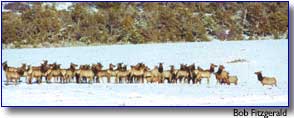|
Jan. 18, 2001
By Janelle Holden journal staff writer The big-game animals that winter on local farms leave their mark on the land. "When you fly, sometimes, it looks like the Serengeti out here. There are just highways of elk — hundreds of them," described Dave Harper, a district wildlife manager with the Colorado Division of Wildlife. Harper recently applied, and received unanimous approval, for a grant from the Montelores Habitat Partnership Program to track "problem" elk who winter north of Lewis on private land, instead of the adjoining San Juan National Forest. The Habitat Partnership Program is funded by up to 5 percent of the deer and elk hunting-license revenues from this geographical area. The committee was formed in 1997 to help solve conflicts between big game and private landowners, with a special emphasis on fence and forage issues. At its January meeting, the HPP committee unanimously approved a $25,000 grant for Harper’s study — to be distributed over a two-year period. Harper hopes the study will definitively show when and where elk live during the year, so that the division can begin to alter the elk’s migration pattern to coincide with landowners’ wishes. The Division of Wildlife currently manages 10,000 head of elk in the three local game areas. The study would be completed out of game management unit 711 and a portion of unit 71 north of Lewis and along the Dolores River Canyon. It will also include areas east of Dove Creek, the East Pines area, and near Groundhog Reservoir. As many as 3,000 head of elk winter between Sage Hen and Dove Creek. The numerous elk have become such a headache for local landowners that the DOW recently allowed three landowners five permits for an off-season dispersal hunt of elk cows. The hunters are only allowed to kill cows or calves. "It’s an experiment to see if we can discourage these animals from causing damage on their property. It wasn’t set up to harvest elk so much as it was to disperse elk off of their property," explained Harper. Once those animals are harvested, the DOW may grant further licenses up until Feb. 28. Harper explained that, for private landowners, elk wintering on their property can cause thousands of dollars of damage to forage and fences. The division does provide fencing for landowners with stacked hay, and there are programs to fund fence repairs, but some landowners are still disgruntled. Stacked hay that is not fenced can often result in the death of an animal. Harper said two elk caught their horns in baler twine and starved to death. One of the landowners involved said that he wanted the DOW to repair the fences, because the labor every year has become too big of a burden for him to handle. "The material is nothing compared to the labor," he said. The landowner, who did not want to be identified, explained the elk’s migration pattern. "If it snows them out up high, and they don’t have much to eat, they’re just kind of like a stray dog. Once they’ve been there they come back." Many of the property owners lease their property to outfitters during the hunting season, and charge over $100 a gun for hunting access. They can receive up to $10,000 a year for this service. These owners are not eligible for game-damage reimbursement, but Harper said "still, their argument is that they are still suffering damages, and that the reason that they are outfitting on their property is to recoup the losses incurred by the elk." However, "not every landowner up here is getting hurt by elk. Some of them don’t mind the elk," countered Harper. Some property owners, such as Chuck McAfee, have enrolled their property in the Conservation Reserve Program, which is specifically designated for wildlife habitat. McAfee said that he has seen as many as 500 head at one time on his place. Right now he is planting a special mix of grasses and shrubs on his CRP acreage to attract the animals. "It’s very difficult to keep elk out of wherever they want to go," admitted McAfee, who praised DOW officers for their help. Harper said the number of elk is not increasing, but in fact was "right at objective." "It’s not that we have that many more elk, it’s just once one comes down here, he brings his cousin the next time. "The problem is, here, we have a majority of those elk wintering in areas that we don’t want them to. We’ve got them in the wrong spot. They’ve learned that it’s easy living over here on this private property with alfalfa fields." Harper believes that many factors have contributed to the elk’s migration. Much of the suitable forage on the forest has been eliminated by drought and livestock. In addition, the intense hunting pressure and numerous roads bisecting the forest may have helped drive the animals to lower elevations. Harper plans to trap and collar elk in late August, when it’s illegal to bait the elk with hay. He plans to hire a special crew of big-game trappers from New Zealand — the Kiwis — as he calls them. The Kiwis fly in a stripped-out helicopter over the elk. Once they have their target, they shoot a net gun — like Spiderman’s finger — over the elk, and then collar them without any sort of stunning weapon. Harper said that the study will help the division adjust their hunting season, "If I capture up these elk by Groundhog, and it shows that those elk stay up there all during hunting season, and won’t cross the fence until after hunting season — it would show we got some kind of problem." The elk head up to the high country again at the end of March or early April, where they typically stay until late November, after hunting season ends.
|
||
|
Copyright © 2001 the Cortez
Journal. All rights reserved. |
